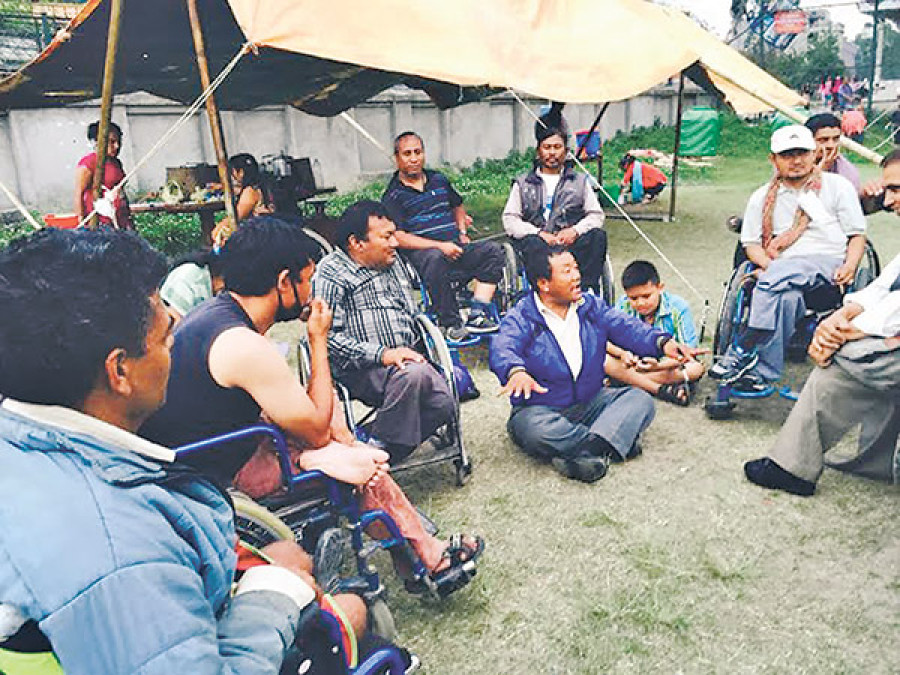Miscellaneous
Overcoming disability
Uday Bahadur Limbu clearly remembers August 21, 1988.
Chahana Sigdel
“Oh I was so scared my wife would leave me,” he declared, drawing a round of laughter, “I know it sounds funny but I am serious. The thought of being left alone was daunting.”
A group of men, some in wheelchairs, some in crutches, surround Limbu; in the backdrop are at least thirty makeshift camps at the open ground opposite of the Central Zoo. They have all taken shelter in open grounds after the earthquake on April 25. “Just imagine one day you are fine and the next moment everything has changed. Think of what happens mentally,” he says.
Almost three decades later, Limbu lives in Kathmandu now and has two kids—a son and a daughter—with the wife who didn’t leave him.
When the Great Quake struck on April 25, Limbu was watching television at his home Chabhil. Usually, he’d be out and about on Saturdays, but that day he had taken off his prosthetic leg, was relaxing and watching a movie when suddenly the ground shook. “The memories came flooding in, but this time I told myself, ‘I wouldn’t run’,” he says.
As the ground shook, Limbu says he stared at the ceiling to see if it would fall. The ceiling didn’t but the TV and the table it was resting on did. They fell on the same leg he had lost many years ago. “You see that. Fell on the same leg,” he says suddenly, pulling out the leg. “It is difficult to live through such an experience all over again. It is important that the people who have suffered such life-changing injuries are treated with proper counseling,” he says, adding, “They need to know this is not the end.”
According to the Disability Promotion Rights Board, 15 people with disabilities lost their lives and some 1,000 people have been made homeless by the Great Quake and its aftershocks. The department is also trying to collect data on the number of people who have been rendered disabled by the earthquake. So far, the Spinal Injury Rehabilitation Centre (SIRC), Kavre, has taken in 50 people, treating them free of cost. The government has also declared that it will prioritise people with disabilities in its reform and rehabilitation scheme.
“It is easy to write and say and all that,” says Bhoj Raj Shrestha, board member of the Independent Living Shelter, and a friend of Limbu’s, sitting on his wheelchair. In the 27-point agreement, the government has ensured people with disabilities will be given priority—including free treatment—but Shrestha says it is important to remain vigilant. “Since ours is such a complicated issue, there are so many hurdles we have to clear— we have to work with so many ministries and all the logistics make it difficult,” he says.
Money, treatment and all are very important, but societal support is equally crucial, says Shrestha, adding that the most important thing is peer counseling. “To see someone like you, to see that you are not the only one who is confined to a wheelchair, to feel a part of the society, that is important,” he says, ”Everyone’s is a special case.”
Shrestha points at two other men, both in wheelchairs. Both the men had suffered serious spinal cord injuries because of an accident. They have lost sense in their two legs. “These two men talk to one another about their problems. They can understand what each other are going through. Even I can’t fully understand their pain,” says Shrestha, who is also wheelchair-bound, after contracting polio at an early age. “At least I have sense in my legs. They don’t. Our stories are different,” he says adding, “You understand, right. The right kind of guidance is important because the pain is not just physical.”




 17.12°C Kathmandu
17.12°C Kathmandu










